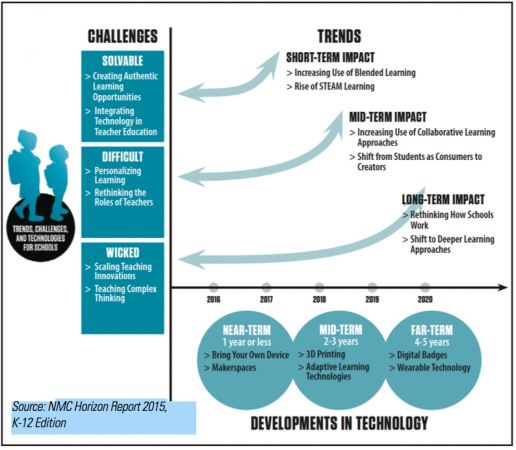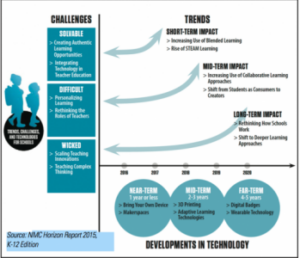This summer the New Media Consortium (NMC), together with the Consortium for School Networking (COSN), released their international K12 Horizon Report. The full report can be accessed here. The following chart helps lay out the big ideas in this report.


In my first article in this series, Dissecting the 2015 K12 Horizon Report, I outlined some of the emerging developments highlighted in the Horizon report. In my second article, I covered some of the key predictive trends for the educational market. In this final piece, I will zoom in on some of the perceived challenges facing the educational market, from a display industry and international perspective.
Horizon Report: Challenges Facing the Ed Tech Market
In its final pages, the 2015 international Horizon report devotes considerable ink to identifying some of the stubborn obstacles currently facing K12 technology efforts. These obstacles are divided into three categories: solvable (those we understand and know how to solve); difficult (those we understand, but any solution remains complex); and wicked (those that are exceedingly difficult to define, let alone solve). Again, with full disclosure I must mention that I served as one of the 56 panelists who developed this report over many months. My findings and commentary follow.
Solvable Challenges
- Creating Authentic Learning Opportunities
- Integrating Technology in Teacher Education
[Len’s commentary] Educators frequently lament that so many learning experiences are purely academic, removed from any reasonable applicability to life. So when learning takes on the appearance of a real workplace challenge, we call it an ‘authentic’ learning experience. What pathway does this suggest for the display industry? It suggests that your sales literature, your booth presence, and your messaging must convey the same message—that authentic learning—not mindless memorization or recall—is made possible through your creative devices.
The Horizon Report also worries about the state of teacher education programs. Here at the University of Colorado-Denver, that’s the area I work in: teacher education. The solvable concern is that we had better start producing teachers that are able to use the wonderful technology you are inventing and promoting in the display industry. Truth be told, there’s a myth about teachers in training. We suspect that, since they are young, these prospective teachers are technology literate. They are not. They know how to text, how to use Instagram, and how to use Pinterest—but perhaps 80% of the students in my required undergrad classes begin their class a bit afraid or timid about technology use. The Horizon Report correctly observes: “This challenge is exacerbated by the fact that digital literacy is less about tools and more about thinking, and thus skills and standards based on tools and platforms have proven to be somewhat ephemeral.”
Bottom line: if you want teachers to use your display technology effectively, you had better start reaching them in the schools where these young professionals are trained. And our efforts need to concentrate on thinking skills delivery, not merely how to operate the technology.
Difficult Challenges
- Personalizing Learning
- Rethinking the Roles of Teachers
[Len’s commentary] According to the Horizon Report, personalized learning is an effort to “address the specific learning needs, interests, aspirations, or cultural backgrounds of individual students.” The report complains: “While there is a demand for personalized learning, it is not adequately supported by current technology or practices.” During recent exhibit hall walkthroughs at educational conferences, I regularly notice that almost every booth is focused on pouring information into the minds of empty-vessel students, using displays, computers, projectors, or the technology du jour. This is the opposite of personalized. One size fits all. When next-gen educators see this, they are flooded with an unwanted emotion—alarm. To them, it’s so anachronistic. In my previous article, I refer to this as a “pathway to extinction.” According to the Horizon Report, “as a result [of the push toward personalized learning], teachers simply cannot take on the same roles they have traditionally held as lecturers and information dispensers.” The Report adds: “This …underscores the need for teachers to rethink their pedagogies and curriculum in ways that enable students to customize their own paths.” Again, what visual messages are conveyed in your sales literature or booth presentations? Can you tap into the “personalized learning” meme instead? Do your graphics portray teachers in old roles or new ones?
Wicked Challenges
- Scaling Teaching Innovations
- Teaching Complex Thinking
[Len’s commentary] How do we take effective display technologies and scale them from one school to many? How do we get from single showcase environments to broad adoption in education? It’s a critical question. And a wicked challenge. Having been associated with many large technology tenders, and especially the accompanying installation RFPs, I know this is one area that is typically done poorly—alienating teachers, principals and communities in the process. The Horizon Report declares the obvious: “Scaling pedagogical innovation requires the removal of restrictive policies, adequate funding, capable leadership, and strong evaluation practices — a tall order for the majority of K-12 public schools, which are receiving fewer resources.” My experience is that the display industry does exceedingly well in assisting schools with the challenge of large tenders—except in the arena of installation. Inept integrators and installers, complex scheduling, incessant finger pointing for mistakes, and the timidity of display companies to warn inexperienced educators who are about to make serious installation mistakes—seem to rule the day.
Make Complex Ideas Understandable
According to the Horizon Report, the term “complex thinking” refers to the ability to understand complexity, a skill that is needed to comprehend how systems work …” Unfortunately, the Horizon Report focuses on coding (programming) as the chief avenue for developing deep thinking in students. Buried deep in its pages is a hint of other possibilities, possibilities that reflect well on the display market: “Another key skill of complex thinking is the ability for students to make complex ideas understandable, using data visualization, media, and other communications techniques.” The trick for the display industry is to help schools understand that, in terms of complex thinking, visual technologies should be a leading argument, not a lagging one—and definitely not a footnote. (LS)

